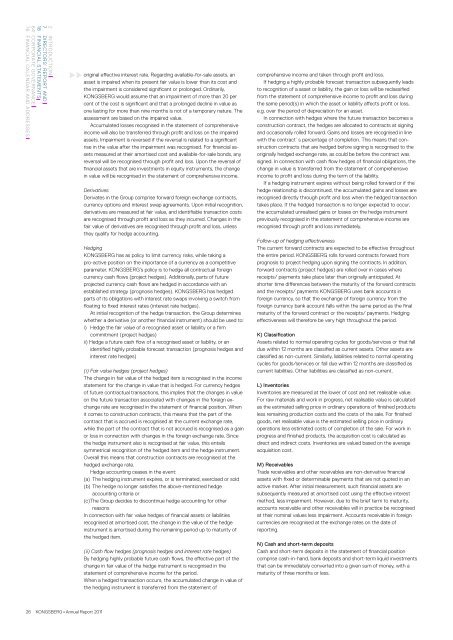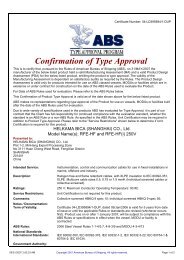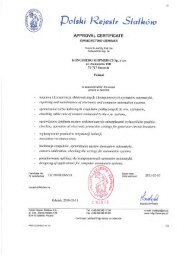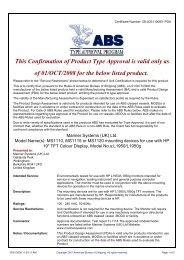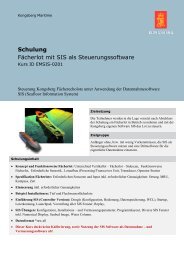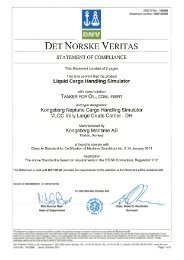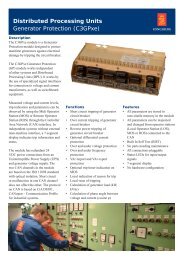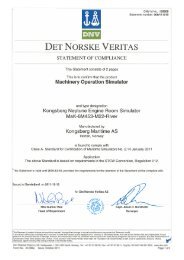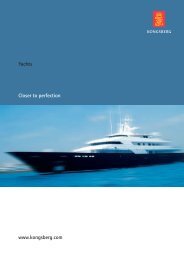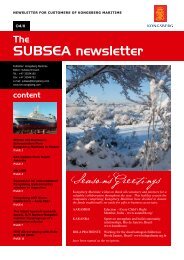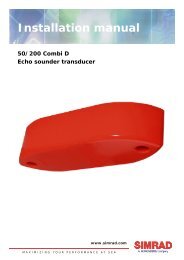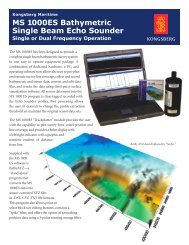Annual Report 2011 - Kongsberg Maritime - Kongsberg Gruppen
Annual Report 2011 - Kongsberg Maritime - Kongsberg Gruppen
Annual Report 2011 - Kongsberg Maritime - Kongsberg Gruppen
You also want an ePaper? Increase the reach of your titles
YUMPU automatically turns print PDFs into web optimized ePapers that Google loves.
2 INTRODUCTION<br />
7 DIRECTORS’ REPORT AND<br />
18 FINANCIAL STATEMENTS<br />
64 CORPORATE GOVERNANCE<br />
76 FINANCIAL CALENDAR AND ADDRESSES<br />
26 KONGSBERG <strong>Annual</strong> <strong>Report</strong> <strong>2011</strong><br />
original effective interest rate. Regarding available-for-sale assets, an<br />
asset is impaired when its present fair value is lower than its cost and<br />
the impairment is considered significant or prolonged. Ordinarily,<br />
KONGSBERG would assume that an impairment of more than 20 per<br />
cent of the cost is significant and that a prolonged decline in value as<br />
one lasting for more than nine months is not of a temporary nature. The<br />
assessment are based on the impaired value.<br />
Accumulated losses recognised in the statement of comprehensive<br />
income will also be transferred through profit and loss on the impaired<br />
assets. Impairment is reversed if the reversal is related to a significant<br />
rise in the value after the impairment was recognised. For financial assets<br />
measured at their amortised cost and available-for-sale bonds, any<br />
reversal will be recognised through profit and loss. Upon the reversal of<br />
financial assets that are investments in equity instruments, the change<br />
in value will be recognised in the statement of comprehensive income.<br />
Derivatives<br />
Derivates in the Group comprise forward foreign exchange contracts,<br />
currency options and interest swap agreements. Upon initial recognition,<br />
derivatives are measured at fair value, and identifiable transaction costs<br />
are recognised through profit and loss as they incurred. Changes in the<br />
fair value of derivatives are recognised through profit and loss, unless<br />
they qualify for hedge accounting.<br />
Hedging<br />
KONGSBERG has as policy to limit currency risks, while taking a<br />
pro-active position on the importance of a currency as a competitive<br />
parameter. KONGSBERG’s policy is to hedge all contractual foreign<br />
currency cash flows (project hedges). Additionally, parts of future<br />
projected currency cash flows are hedged in accordance with an<br />
established strategy (prognosis hedges). KONGSBERG has hedged<br />
parts of its obligations with interest rate swaps involving a switch from<br />
floating to fixed interest rates (interest rate hedges).<br />
At initial recognition of the hedge transaction, the Group determines<br />
whether a derivative (or another financial instrument) should be used to:<br />
i) Hedge the fair value of a recognised asset or liability or a firm<br />
commitment (project hedges)<br />
ii) Hedge a future cash flow of a recognised asset or liability, or an<br />
identified highly probable forecast transaction (prognosis hedges and<br />
interest rate hedges)<br />
(i) Fair value hedges (project hedges)<br />
The change in fair value of the hedged item is recognised in the income<br />
statement for the change in value that is hedged. For currency hedges<br />
of future contractual transactions, this implies that the changes in value<br />
on the future transaction associated with changes in the foreign exchange<br />
rate are recognised in the statement of financial position. When<br />
it comes to construction contracts, this means that the part of the<br />
contract that is accrued is recognised at the current exchange rate,<br />
while the part of the contract that is not accrued is recognised as a gain<br />
or loss in connection with changes in the foreign exchange rate. Since<br />
the hedge instrument also is recognised at fair value, this entails<br />
symmetrical recognition of the hedged item and the hedge instrument.<br />
Overall this means that construction contracts are recognised at the<br />
hedged exchange rate.<br />
Hedge accounting ceases in the event:<br />
(a) The hedging instrument expires, or is terminated, exercised or sold<br />
(b) The hedge no longer satisfies the above-mentioned hedge<br />
accounting criteria or<br />
(c) The Group decides to discontinue hedge accounting for other<br />
reasons<br />
In connection with fair value hedges of financial assets or liabilities<br />
recognised at amortised cost, the change in the value of the hedge<br />
instrument is amortised during the remaining period up to maturity of<br />
the hedged item.<br />
(ii) Cash flow hedges (prognosis hedges and interest rate hedges)<br />
By hedging highly probable future cash flows, the effective part of the<br />
change in fair value of the hedge instrument is recognised in the<br />
statement of comprehensive income for the period.<br />
When a hedged transaction occurs, the accumulated change in value of<br />
the hedging instrument is transferred from the statement of<br />
com prehensive income and taken through profit and loss.<br />
If hedging a highly probable forecast transaction subsequently leads<br />
to recognition of a asset or liability, the gain or loss will be reclassified<br />
from the statement of comprehensive income to profit and loss during<br />
the same period(s) in which the asset or liability affects profit or loss,<br />
e.g. over the period of depreciation for an asset.<br />
In connection with hedges where the future transaction becomes a<br />
construction contract, the hedges are allocated to contracts at signing<br />
and occasionally rolled forward. Gains and losses are recognised in line<br />
with the contract`s percentage of completion. This means that construction<br />
contracts that are hedged before signing is recognised to the<br />
originally hedged exchange rate, as could be before the contract was<br />
signed. In connection with cash flow hedges of financial obligations, the<br />
change in value is transferred from the statement of comprehensive<br />
income to profit and loss during the term of the liability.<br />
If a hedging instrument expires without being rolled forward or if the<br />
hedge relationship is discontinued, the accumulated gains and losses are<br />
recognised directly through profit and loss when the hedged transaction<br />
takes place. If the hedged transaction is no longer expected to occur,<br />
the accumulated unrealised gains or losses on the hedge instrument<br />
previously recognised in the statement of comprehensive income are<br />
recognised through profit and loss immediately.<br />
Follow-up of hedging effectiveness<br />
The current forward contracts are expected to be effective throughout<br />
the entire period. KONGSBERG rolls forward contracts forward from<br />
prognosis to project hedging upon signing the contracts. In addition,<br />
forward contracts (project hedges) are rolled over in cases where<br />
receipts/ payments take place later than originally anticipated. At<br />
shorter time differences between the maturity of the forward contracts<br />
and the receipts/ payments KONGSBERG uses bank accounts in<br />
foreign currency, so that the exchange of foreign currency from the<br />
foreign currency bank account falls within the same period as the final<br />
maturity of the forward contract or the receipts/ payments. Hedging<br />
effectiveness will therefore be very high throughout the period.<br />
K) Classification<br />
Assets related to normal operating cycles for goods/services or that fall<br />
due within 12 months are classified as current assets. Other assets are<br />
classified as non-current. Similarly, liabilities related to normal operating<br />
cycles for goods/services or fall due within 12 months are classified as<br />
current liabilities. Other liabilities are classified as non-current.<br />
L) Inventories<br />
Inventories are measured at the lower of cost and net realisable value.<br />
For raw materials and work in progress, net realisable value is calculated<br />
as the estimated selling price in ordinary operations of finished products<br />
less remaining production costs and the costs of the sale. For finished<br />
goods, net realisable value is the estimated selling price in ordinary<br />
operations less estimated costs of completion of the sale. For work in<br />
progress and finished products, the acquisition cost is calculated as<br />
direct and indirect costs. Inventories are valued based on the average<br />
acquisition cost.<br />
M) Receivables<br />
Trade receivables and other receivables are non-derivative financial<br />
assets with fixed or determinable payments that are not quoted in an<br />
active market. After initial measurement, such financial assets are<br />
subsequently measured at amortised cost using the effective interest<br />
method, less impairment. However, due to the brief term to maturity,<br />
accounts receivable and other receivables will in practice be recognised<br />
at their nominal values less impairment. Accounts receivable in foreign<br />
currencies are recognised at the exchange rates on the date of<br />
reporting.<br />
N) Cash and short-term deposits<br />
Cash and short-term deposits in the statement of financial position<br />
comprise cash-in-hand, bank deposits and short-term liquid investments<br />
that can be immediately converted into a given sum of money, with a<br />
maturity of three months or less.


